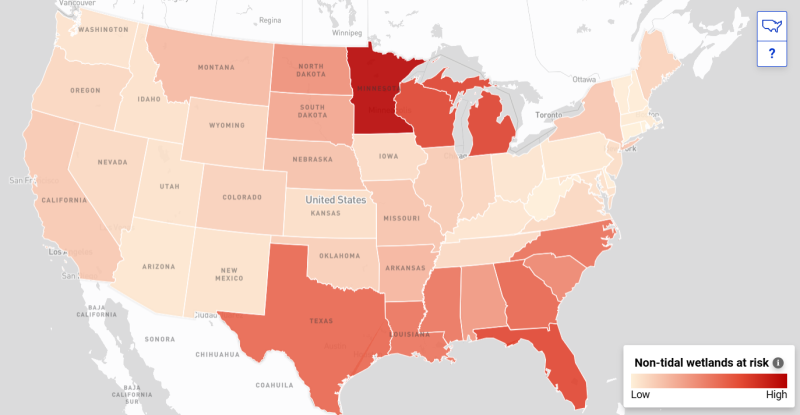How the Supreme Court put the nation’s wetlands at risk

In 2023, a majority opinion by the Supreme Court (Sackett v EPA) drastically scaled back federal protections for America’s wetlands, potentially threatening the communities and ecosystems that depend on them for critical habitat and flood protection.
Prior to the decision, the Supreme Court and lower courts upheld that wetlands that are connected to federal waterways, including those connected below the surface, should be protected. The Supreme Court opinion now states that wetlands must have “a continuous surface connection” to federal waters, an approach that is not grounded in science and establishes tremendous uncertainty as to how this will be interpreted in the long term.
Explore EDF's analysis of threatened wetlands
Wetlands are pivotal in protecting communities from flooding, our nation’s costliest natural hazard, because they act as natural sponges that slow and absorb floodwaters, reducing downstream flood damages. With one acre of wetlands storing as much as 1.5 million gallons of flood water, continued loss of wetlands and development in high-risk areas will only exacerbate the impacts of climate change and put more communities at risk of flooding. Wetlands also clean our water and are home to 40% of the world’s species and 75% of commercially harvested fish and shellfish species in the U.S.
What we've found
Analysis from EDF estimates that between 17-90 million acres of wetlands could be threatened (for reference, the entire state of California is 100 million acres).* And it is possible that the analysis may miss many wetlands smaller than an acre, meaning the numbers are likely even higher. The Supreme Court’s decision is compounded by the fact that many states have few or no state protections, with 24 states currently relying entirely on the federal protections determined by the Clean Water Act for their wetlands. In short, many of these wetlands may have no protection at all.

How EDF is working to protect wetlands
EDF is working together with scientists, advocates and policymakers to better quantify, communicate and protect the breadth and value of benefits that wetlands provide, including their flood risk reduction benefits. This will require cutting-edge advancements in science and economics, as well as partnerships across a wide spectrum of stakeholders and policy action. We’re also creating a better public understanding of the benefits that wetlands provide, including water and flood management.
* These results are estimates provided for informational purposes only and do not represent actual federal jurisdictional status as determined by the U.S. government. For more detail, refer to the analysis here. For more information, contact wetlands@edf.org.
Resources
- Press release
Science publishes EDF analysis warning up to 90 million acres of wetlands may now be at risk
- Article
Why should we protect wetlands? Because wetlands protect us
- Blog post
On this International Day for Disaster Risk Reduction, protecting the Nation’s wetlands is more important and urgent than ever
- Blog post
Our Nation’s wetlands are at risk. So is our ability to manage flooding.
- Blog post
Three ways to take bold action to protect urban coastal wetlands
- Blog post
Six reasons why wetlands are vital every month of the year.
MEDIA CONTACT
Jenny Tolep
248-410-2666 (office)
Samantha Tausendschoen
(715) 220-9930 (office)













